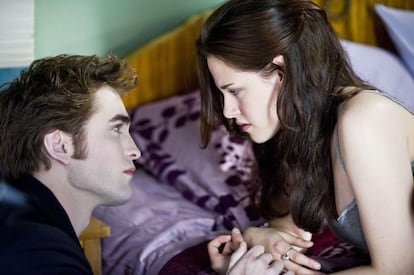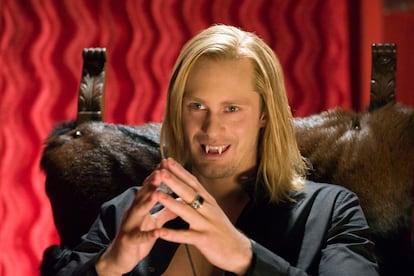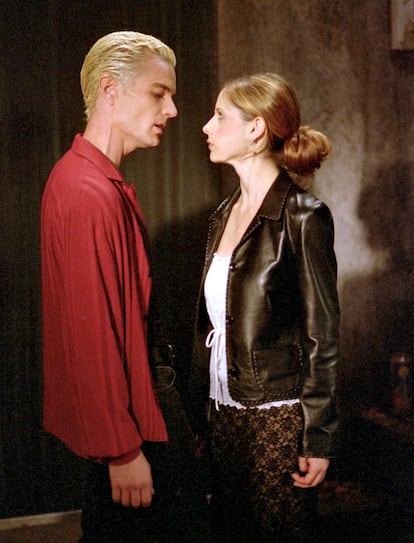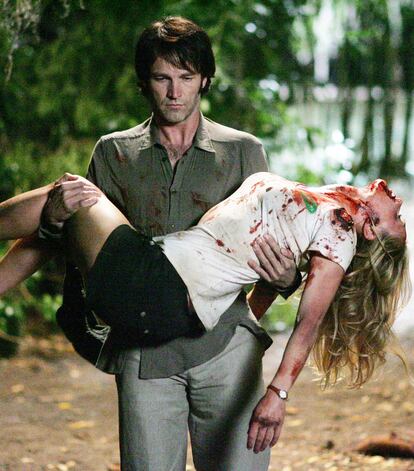Leaving the shadows for passion: Why vampires are classic monsters that best reflect our fears and desires
In the 2000s, there was a boom in vampire-inspired movies and TV shows, which triumphed among teenagers. These mythical nocturnal creatures went from being monstrous and terrifying to arousing desire and connecting with an entire generation

A fawn strolling peacefully through a vast American forest of evergreen trees is about to be devoured by an unexpected predator: a vampire. During the stillness that precedes the hunt, a voice-over recites the sentence that begins one of the most iconic sagas of millennial pop culture: “I’d never given much thought to how I would die. But dying in the place of someone I love, seems like a good way to go.” This is one of the many quotes from the movie Twilight that stayed with teenagers, who lined their school books and bedroom walls with images of the film’s stars.
Myths surrounding vampires may have evolved and transformed over time, but they still remain present in contemporary pop culture. “The vampire is the only classic monster that has managed to adapt to the times because it has gone from reflecting our fears to also embodying our desires,” explains David Remartínez, a journalist and the author of Una historia pop de los vampiros (A Pop History of Vampires).
The film adaptations of Stephenie Meyer’s famous Twilight book saga were undoubtedly the pinnacle of the vampire narrative trend of the 21st century. But many other works also made a deep mark on teenagers’ collective consciousness, such as the TV series Buffy the Vampire Slayer, True Blood and The Vampire Diaries. In these shows, the plot was marked by supernatural powers and revolved around dark, young and beautiful creatures falling in and out of love with each other and with human beings. Gone were the terrifying features of Murnau’s Nosferatu and the cursed castle of Bram Stoker’s Dracula. These vampires put aside their evil nature, have an eternally beautiful face and body, and symbolize many human desires.

Teenage spirit
“Every era has had a vampire to represent it. These reinterpretations and adaptations of previous myths are always made in an effort to speak to a new generation that identifies with them,” reflects Julio Pérez Manzanares, doctor in art history from the Complutense University of Madrid and author of the book Dracula Superstar.
Part of the reason vampire stories are still so relevant is that these narratives embody many adolescent fantasies. Vampire movies and TV shows share several common characteristics: the protagonists are young, handsome, mysterious, rebellious and seductive. The desire to be alternative, special and different from the rest is not unusual among teenagers.
What’s more, the vampire is presented as an aspirational model in TV shows and movies: it is attractive precisely because of its torments and pleasures, which match what is experienced in the turbulent period of adolescence. “All these shows have connected with their audiences because they have promised them a fantasy adolescence, where their feelings and powers are opposed to those of the adult world,” explains Remartínez.

Other topics that attract most young people like moths to the light are eroticism and romanticism. Some have not experienced these feelings, others confuse it for friendship, while some are just starting to get a sense of these issues. In any case, it’s a theme that arouses curiosity. “Vampires in the 21st century can have sex, which was previously forbidden by religion. Dracula bit, but he didn’t have sex. Today, young vampires are not even afraid of the sun, let alone the crucifix. They are terrified of falling out of love, and that alone explains their evolution,” says Remartínez.
The public’s preference for romantic rather than scary vampires — in the 1990s, Buffy even fell in love with them while hunting them down — is reflected in figures. A YouTube video talking about the TV series The Vampire Diaries has 378,000 views and more than 1,900 comments. The show has become famous for its passionate kissing scenes, love affairs and suspense, with the audience kept on edge wondering who the characters will fall for next.
“As the figure [of the vampire] has become more familiar and new nuances have been added to reflect social changes, the vampire has become a kind of rock star, who is much more desirable than the good guy in the movie,” explains Pérez Manzanares.
This trend is also apparent in 21st-century vampire films that are not intended for teenagers, such as Jim Jarmusch’s Only Lovers Left Alive, a romance movie about two vampires who enjoy lounging on the sofa together, wearing glamorous outfits, hiding from the sun behind Ray Bans and living amid electric guitars and piles of books — they are just like rock stars in love and lost in the sea of centuries they have lived together.
Traces of past passions
The city of Forks is practically an amusement park. Visitors can stay in the farmhouse that was the inspiration for Bella’s Swan House in Twilight. A van is parked out front in the same position it is in the movie, there is a museum with objects from the saga and a huge welcome sign warns of the dangers of coming across vampires.
If you search for “Forks” on Instagram or TikTok, you will see many videos of people who visited the city in Washington precisely because of Twilight. This is despite the fact the movie saga was actually filmed in Oregon and the Canadian city of Vancouver. But Forks knew how to take advantage of the movie’s popularity: it talks about the saga on its tourism website and even organizes an annual themed festival.
“Within the fan phenomenon and mythomania, the pilgrimage to the place where you feel ‘part of history’ has always been very important. The paradox of the matter is that those places, certainly, were never real. This is evident in the case of Dracula’s castle in Transylvania, which was never visited by this historical figure,” says Pérez Manzanares.

The continued popularity of these modern vampire series — which are essentially aimed at teenagers — also comes down to nostalgia and the desire to relieve the past. Series like True Blood remain current — Netflix added it to its catalog at the end of 2023 — and it is very easy to find T-shirts and memes related to this universe. “The recurrence and nostalgic survival of icons is fundamental for them to be part of the collective popular ideology,” says Pérez Manzanares.
In short, there are several reasons why vampire-themed series and films proliferated and triumphed in equal parts during the early 2000s, offering new narratives and perceptions of a monster that — despite having shown romanticism, sensitivity and glimpses of humanity in previous versions, as in Bram Stoker’s iconic Dracula — continues to be feared, ruthless and capable of committing any aberration.
Perhaps when we can not achieve what we long for in reality, we turn to fantasy — especially in such a convulsive stage as adolescence, when no one seems to understand you anymore. We seek escapism in books, movies and all those other mediums where it is possible to dream of a higher and more exciting version of ourselves, where vampires dazzle in the sunlight and speak with a convoluted language that, at the time, we found enchanting.
Sign up for our weekly newsletter to get more English-language news coverage from EL PAÍS USA Edition
Tu suscripción se está usando en otro dispositivo
¿Quieres añadir otro usuario a tu suscripción?
Si continúas leyendo en este dispositivo, no se podrá leer en el otro.
FlechaTu suscripción se está usando en otro dispositivo y solo puedes acceder a EL PAÍS desde un dispositivo a la vez.
Si quieres compartir tu cuenta, cambia tu suscripción a la modalidad Premium, así podrás añadir otro usuario. Cada uno accederá con su propia cuenta de email, lo que os permitirá personalizar vuestra experiencia en EL PAÍS.
¿Tienes una suscripción de empresa? Accede aquí para contratar más cuentas.
En el caso de no saber quién está usando tu cuenta, te recomendamos cambiar tu contraseña aquí.
Si decides continuar compartiendo tu cuenta, este mensaje se mostrará en tu dispositivo y en el de la otra persona que está usando tu cuenta de forma indefinida, afectando a tu experiencia de lectura. Puedes consultar aquí los términos y condiciones de la suscripción digital.
More information
Archived In
Últimas noticias
Most viewed
- Sinaloa Cartel war is taking its toll on Los Chapitos
- Oona Chaplin: ‘I told James Cameron that I was living in a treehouse and starting a permaculture project with a friend’
- Reinhard Genzel, Nobel laureate in physics: ‘One-minute videos will never give you the truth’
- Why the price of coffee has skyrocketed: from Brazilian plantations to specialty coffee houses
- Silver prices are going crazy: This is what’s fueling the rally









































